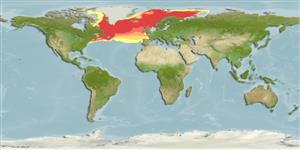Environment: milieu / climate zone / depth range / distribution range
Ökologie
seewasser; ozeanodrom (Ref. 51243); tiefenbereich 100 - 1000 m, usually 100 - 500 m (Ref. 35388). Temperate; 3°C - 7°C (Ref. 35388); 79°N - 39°N, 75°W - 71°E
Eastern Atlantic: Kattegat and North Sea, northward to Spitsbergen, southern part of Barents Sea eastward to Kanin Banks and Novaya Zemlya, rare in White Sea, Iceland and eastern Greenland. Western Atlantic: Greenland and southeastern Labrador in Canada to New Jersey in USA (Ref. 7251).
Length at first maturity / Size / Gewicht / Alter
Maturity: Lm 38.9, range 38 - 41 cm
Max length : 100.0 cm TL Männchen/unbestimmt; (Ref. 4570); common length : 45.0 cm TL Männchen/unbestimmt; (Ref. 4570); max. veröff. Gewicht: 15.0 kg (Ref. 35388); max. veröff. Alter: 60 Jahre (Ref. 35388)
Found off the coast from 100-1000 m; juveniles found in fjords, bays and inshore waters. Normally trawled in deep water (Ref. 9988). Benthic (Ref. 5951). Feed mostly on euphausiids in summer; herrings in autumn and winter; capelins, herrings, euphausiids and ctenophores in spring. Gregarious throughout life. A slow growing species (Ref. 9988). Ovoviviparous, gonads of male and female do not mature at the same time. The spermatozoa are kept in the ovary of the female after copulation until such time that the eggs ripen paving the way for fertilization (Ref. 74488). Copulation takes place in late summer or early autumn (Ref. 35388, 34817); in winter females give birth to 50,000-350,000 pelagic larvae of 8 mm length (Ref. 35388). Utilized fresh and frozen; eaten fried, broiled, microwaved and baked (Ref. 9988).
Gonads of male and female do not mature at the same time. The spermatozoa are kept in the ovary of the female after copulation until such time that the eggs ripen paving the way for fertilisation (Ref. 74488). Gives birth to 50,000-350,000 pelagic larvae of 8 mm length (Ref. 35388).
Fernholm, B. and A. Wheeler, 1983. Linnaean fish specimens in the Swedish Museum of Natural History, Stockholm. Zool. J. Linn. Soc., 78(3):199-286. (Ref. 83993)
IUCN Rote Liste Status (Ref. 130435)
Bedrohung für Menschen
Reports of ciguatera poisoning (Ref. 30911)
Nutzung durch Menschen
Fischereien: hoch kommerziell; Sportfisch: ja
Tools
Zusatzinformationen
Download XML
Internet Quellen
Estimates based on models
Preferred temperature (Ref.
123201): 0.6 - 9.3, mean 3.7 °C (based on 1514 cells).
Phylogenetic diversity index (Ref.
82804): PD
50 = 0.5000 [Uniqueness, from 0.5 = low to 2.0 = high].
Bayesian length-weight: a=0.01380 (0.00638 - 0.02986), b=3.04 (2.86 - 3.22), in cm total length, based on LWR estimates for this Genus-body shape (Ref.
93245).
Trophic level (Ref.
69278): 4.0 ±0.68 se; based on food items.
Widerstandsfähigkeit (Ref.
120179): niedrig, Verdopplung der Population dauert 4,5 - 14 Jahre. (rm=0.23; K=0.06-0.08; tm=10-12; tmax=60; Fec= 19,000-350,000).
Prior r = 0.30, 95% CL = 0.20 - 0.45, Based on 5 full stock assessments.
Fishing Vulnerability (Ref.
59153): High to very high vulnerability (71 of 100).
Climate Vulnerability (Ref.
125649): High to very high vulnerability (69 of 100).
Nutrients (Ref.
124155): Calcium = 12.3 [5.5, 33.4] mg/100g; Iron = 0.23 [0.10, 0.51] mg/100g; Protein = 18.3 [17.1, 19.5] %; Omega3 = 1.29 [0.51, 3.25] g/100g; Selenium = 44.8 [19.0, 116.1] μg/100g; VitaminA = 20.7 [6.3, 68.0] μg/100g; Zinc = 0.342 [0.187, 0.613] mg/100g (wet weight); based on
nutrient studies.
